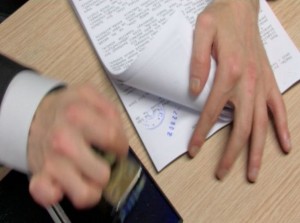The Hirshhorn Turns Labor Into Art with “Black Box: Ali Kazma”
Turkish video artist Ali Kazma captures the actions of a man who seems to be the most efficient stamper of paper ever at the Hirshhorn’s Black Box Theater
/https://tf-cmsv2-smithsonianmag-media.s3.amazonaws.com/filer/20120110110011Cropped.jpg)
Step into the Hirshhorn’s Black Box theater and you’ll find Turkish video artist Ali Kazma’s “O.K” (2010) showing on seven small screens arranged across the wall. Looped and played in real time, each shows a different perspective of the hands of a notary public rapidly stamping piles and piles of paper with extreme expediency. The cacophony of sound and the repetition of imagery becomes more and more hypnotic the longer the viewer stays in the theater.
“I sought someone out who was really fast and had nice hands,” Kazma told Art in America this past September of his subject. That well-manicured, faceless worker smartly dressed in a slim-fitting gray suit becomes a highly efficient machine in “O.K.”–with no assistance from rubber-tipped fingers or the stationary equivalent of steroids. Just a man, his piles of paper and a stamper.

Still from Ali Kazma's "O.K.," 2010, courtesy of C24 Gallery and Vehbi Koç Foundation, New York.
“We, especially in the art world, are always talking about the idea that the world has moved on, that the world has become a superhighway of information, that it’s mobile.” Kazma continued. “But I wanted to remind us all that we still live in a world where such work as stamping papers exists.”
The blitzkrieg of rapid-fire sound and movement in a generic office setting immediately triggered my memories of the classic 1980s Federal Express commercials featuring motor-mouthed John Moschitta. And watching detailed images of people at work brought to mind Eadweard Muybridge’s early photo studies of human movement.
“The work is mesmerizing but also redolent of the caffeine-infused work-a-day tasks we all hope we accomplish as masterfully,” says Hirshhorn curator Barbara Gordon. “Kazma seems to ask us to slow down, to sit and take in, to appreciate and consider the process, and progress of as well, the so-called fruits of our labor.
“Black Box: Ali Kazma” will be on display at the Hirshhorn Museum until April 2012
/https://tf-cmsv2-smithsonianmag-media.s3.amazonaws.com/accounts/headshot/Jeff-Campagna-240.jpg)
/https://tf-cmsv2-smithsonianmag-media.s3.amazonaws.com/accounts/headshot/Jeff-Campagna-240.jpg)